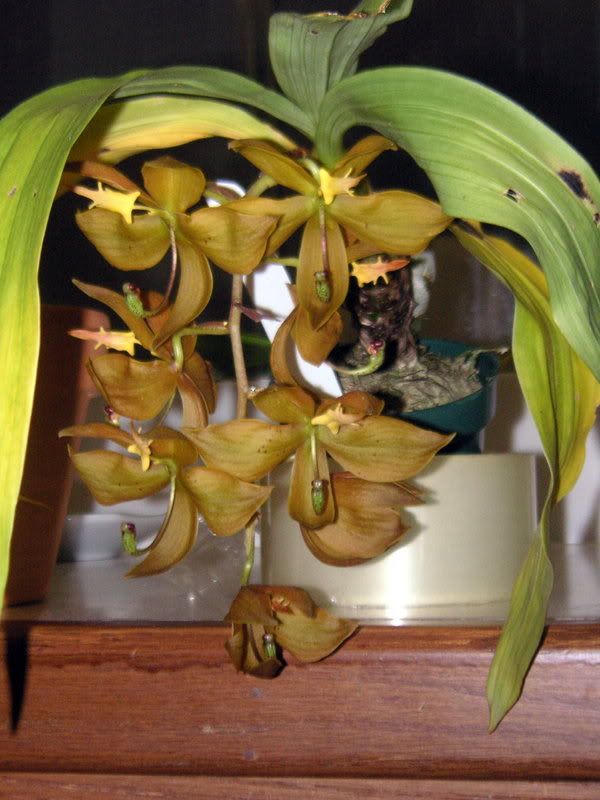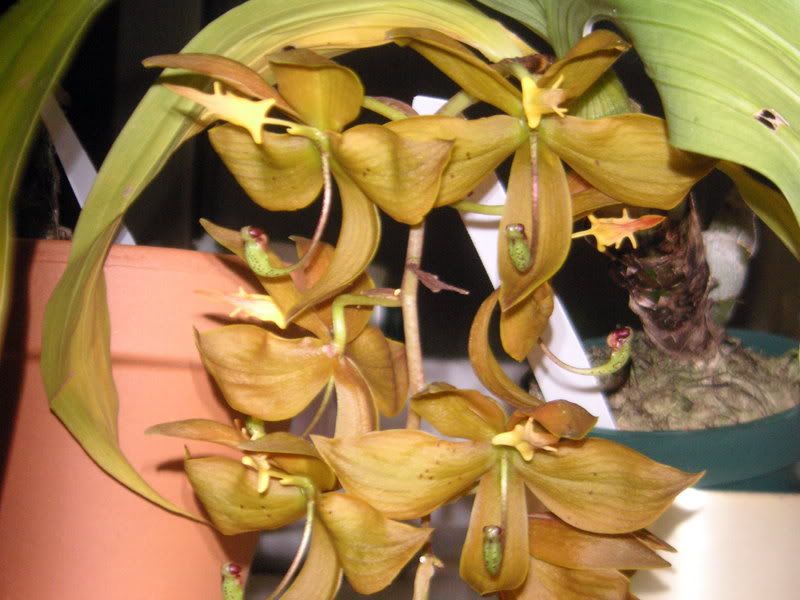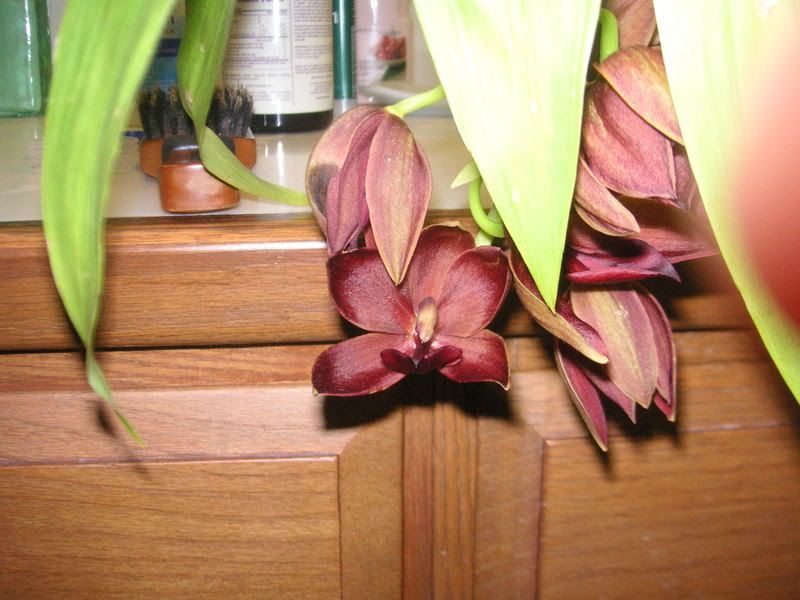


Donate Now
and become
Forum Supporter.

Many perks!
<...more...>


|

01-27-2008, 02:34 AM
|
|
Senior Member
|
|
Join Date: Dec 2007
Zone: 10b
Location: Carmel CA
Posts: 221
|
|
 Cycnoches hybrids...can I cross them?
Cycnoches hybrids...can I cross them?
Cycnoches barthiorum 'Sunset Valley Orchids' x Mormolyca colossus 'Ron Kaufmann' and Cycnoches William Clark are in full bloom and I'd love to cross them BUT....is it possible?
Species cycnoches are hard to pollinate so I have no idea how to pull this off. Any suggestions?
-Mateo
|

01-27-2008, 05:11 AM
|
|
Senior Member
|
|
Join Date: Jul 2007
Zone: 7a
Location: Southwest of Germany
Posts: 2,064
|
|
Hello mrobert,
the first plant is an intergeneric hybrid with Mormodes colossus, therefor flowers should show no sexual dimorphism. It means that the flowers have fully develloped male and female parts, and you can use it to produce a seed capsule.
The other plant is a cross between Cycnoches cooperi and Cycnoches herrenhusanum. So it is a pure Cycnoches, which means it has either male or female flowers, eventually hermaphrodite ones. Without a picture and without further data we cannot know.
A cross between both is basically possible, but you need a pod parent and a pollen parent. If you want, post photos, eventually closeups of column of both of them.
Mormolyca is quite a different genus.
|

01-27-2008, 08:50 PM
|
|
Senior Member
|
|
Join Date: Dec 2007
Zone: 10b
Location: Carmel CA
Posts: 221
|
|
Pictures, of course, why didn't I think of that. Here is what we are dealing with:




I can get better picture but for expediency these will have to do for now. If you need additional images let me know what parts to focus on (I'm guessing using macro settings on the reproductive parts).
Thanks again- Mateo
Last edited by mrobert; 01-27-2008 at 08:52 PM..
Reason: na
|

01-27-2008, 10:29 PM
|
|
Senior Member
|
|
Join Date: Jul 2007
Zone: 7a
Location: Southwest of Germany
Posts: 2,064
|
|
Thanks. First picture is Cycnoches William Clark with 8 male flowers. I see the sex from the slender long column and the lips with fingerlike protrusions. If you remove the anthere cap, you can pull out the pollinia.
Next picture with red flowers is Cycnodes (Cycnoches x Mormodes). Flowers have no sexual dimorphism. It means you can either use the male (pollinia) or the female (stigma) part. This is the sticky part underneath the column, following my arrow.
To make a cross, take the pollinia from Cycnoches with a pin or matchstick, wait for 30 - 60 minutes to let them get dry a little, then put it on the stigma of your Cycnodes.
Then keep your fingers crossed for success.
|

01-27-2008, 10:44 PM
|
|
Senior Member
|
|
Join Date: Dec 2007
Zone: 10b
Location: Carmel CA
Posts: 221
|
|
Is there a best time to do this during the life cycle of the flower? Both plants have have flowers open for about a week. If I do get seeds....we'll talk about that later.
Thank you so much!
|

01-28-2008, 04:25 AM
|
|
Senior Member
|
|
Join Date: Jul 2007
Zone: 7a
Location: Southwest of Germany
Posts: 2,064
|
|
A strong scent is a good sign - it attracks pollinators. The time is right. Don´t wait for longer.
Pollinia can even be taken from a withered flower.
|

01-28-2008, 04:52 PM
|
|
Senior Member
|
|
Join Date: Dec 2007
Zone: 10b
Location: Carmel CA
Posts: 221
|
|
I started to attempt this before work this morning. The pollinia on the male flowers actually ejected and "glued" to my finger with a gooey like substance. I'll try to film it after work today as the trigger/projection mechanism is a marvel. Now that I have the pollinia from the male flower (it looks like a yellow grain of sand correct?) do I just have to place it on the stigma of the mormodes or do i need to break it then place it? Thanks for all the help, f this is a success I'll be sure to send you the "results" in a few years.
Also, Fred Clarke wrote back to me and said it could be a nice cross. I wonder if it has been done before?
|

01-28-2008, 07:24 PM
|
|
Senior Member
|
|
Join Date: Jul 2007
Zone: 7a
Location: Southwest of Germany
Posts: 2,064
|
|
Not only the trigger mechanism, also the mechanism of the pollinarium is a marvel. The pollinarium consists of three parts: the sticky disc called viscidium, the stem called stipes and two pollinia on top.
Once you take out the pollinarium and adhere the apparatus to a foundation, its position is horizontal. Be patient and watch it slowly arising. All this is to prevent self pollination.
But your question: I pluck off the pollinia and place the entire pollinia on the stigma. With a microscope you can see that the pollinia grow tubular like long protrusions within the next hours to enter the female tissue.
|

01-29-2008, 02:05 AM
|
|
Senior Member
|
|
Join Date: Dec 2007
Zone: 10b
Location: Carmel CA
Posts: 221
|
|
I observed the action of the Mormodes as you described...fascinating. I'll let keep this thread up to date with any and all developments.
|

01-29-2008, 05:09 AM
|
|
Senior Member
|
|
Join Date: Jul 2007
Zone: 7a
Location: Southwest of Germany
Posts: 2,064
|
|
Also Mormodes has a twisted column. Some authors say that Mormodes twist their column and stigma to the other side, away from the lip, once they are pollinated. But I was not yet able to observe and confirm.
And an intergeneric hybrid doesn´t have a torsion.
|
|
Currently Active Users Viewing This Thread: 1 (0 members and 1 guests)
|
|
|
 Posting Rules
Posting Rules
|
You may not post new threads
You may not post replies
You may not post attachments
You may not edit your posts
HTML code is Off
|
|
|
All times are GMT -4. The time now is 02:33 PM.
|
































 Linear Mode
Linear Mode


